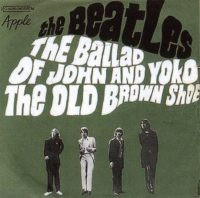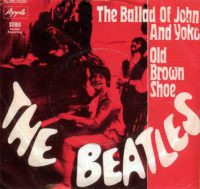“The Ballad Of John And Yoko” stands as a unique entry in The Beatles’ illustrious catalog. Released in 1969, this song offers an intimate glimpse into the whirlwind romance and marriage of John Lennon and Yoko Ono. Penned by Lennon and credited to Lennon-McCartney, the track is notable not just for its autobiographical lyrics but also for its remarkably swift creation and recording process, primarily featuring only John Lennon and Paul McCartney.
A Honeymoon Chronicle Set to Music
The song’s origins are deeply rooted in the immediate aftermath of John Lennon and Yoko Ono’s wedding on March 20, 1969, in Gibraltar. Lennon himself described the song as “journalism” and a “folk song,” conceived during their honeymoon in Paris. “The Ballad of John and Yoko” meticulously chronicles the events surrounding their nuptials and subsequent honeymoon phase, acting as a musical diary of their experiences. From the urgency to get married to facing obstacles and public attention, the lyrics lay bare the personal journey of the newlyweds.
It was very romantic. It’s all in the song, ‘The Ballad Of John And Yoko’, if you want to know how it happened, it’s in there. Gibraltar was like a little sunny dream. I couldn’t find a white suit – I had sort of off-white corduroy trousers and a white jacket. Yoko had all white on.
John Lennon, Rolling Stone, 1970
This quote from Lennon underscores the song’s autobiographical nature, emphasizing its role as a direct account of their experiences. The lyrics vividly paint scenes from Gibraltar to Paris and Amsterdam, offering listeners a front-row seat to the unfolding events.
A Speedy Studio Collaboration Between Lennon and McCartney
On April 14, 1969, driven by an eagerness to capture his freshly written song, Lennon visited McCartney at his London home. The pair finalized the song’s composition swiftly and, without delay, headed to Abbey Road Studios. What transpired was an unusually efficient recording session. “The Ballad of John and Yoko” was recorded in a single day, primarily featuring Lennon on lead vocals, lead guitar, and acoustic guitar, and McCartney contributing harmony vocals, bass, drums, piano, and maracas. This collaboration marked a period of renewed creative energy between Lennon and McCartney.
John was in an impatient mood so I was happy to help. It’s quite a good song; it has always surprised me how with just the two of us on it, it ended up sounding like The Beatles.
Paul McCartney, Many Years From Now, Barry Miles
McCartney’s reflection highlights the spontaneous and collaborative spirit of the recording. Despite the absence of George Harrison and Ringo Starr, the resulting track remarkably retained the signature sound of The Beatles, a testament to the musical synergy between Lennon and McCartney.
Controversy and “Christ”: Navigating Public and Religious Sensitivities
Lyrically, “The Ballad of John and Yoko” is perhaps most remembered for the line, “Christ, you know it ain’t easy, You know how hard it can be. The way things are going, They’re gonna crucify me.” This line immediately sparked controversy, particularly in light of Lennon’s earlier controversial remarks about The Beatles being “more popular than Jesus.” Aware of the potential backlash, Lennon attempted to manage the song’s pre-release publicity, aiming to downplay the “Christ” reference.
[ The Ballad Of John And Yoko single artwork – France](France single artwork for The Ballad Of John And Yoko, showcasing its international release.)
The Ballad Of John And Yoko single artwork – France](France single artwork for The Ballad Of John And Yoko, showcasing its international release.)
Despite these efforts, the song faced bans and censorship from numerous radio stations in both the US and the UK. Some stations outright banned the song, while others opted to bleep out the word “Christ.” This censorship underscores the social and religious sensitivities of the time and the powerful reactions Lennon’s lyrics could provoke.
Tony – No pre-publicity on Ballad Of John & Yoko especially the ‘Christ’ bit – so don’t play it round too much or you’ll frighten people – get it pressed first. John
Memo to Apple plugger Tony Bramwell, written by John Lennon
This memo reveals Lennon’s awareness of the potentially inflammatory nature of the lyrics and his attempt to mitigate negative reactions.
Release, B-Side, and Musical Echoes
“The Ballad of John and Yoko” was released as a single in May 1969, with George Harrison’s “Old Brown Shoe” as the B-side. Musically, the song has drawn comparisons to earlier rock and roll. Notably, the bass line and closing guitar riff bear a striking resemblance to “Lonesome Tears In My Eyes” by The Rock And Roll Trio, a song The Beatles themselves had covered in their early days and even recorded for the BBC.
[ The Ballad Of John And Yoko single artwork – Germany](German single artwork for The Ballad Of John And Yoko, illustrating its global distribution.)
The Ballad Of John And Yoko single artwork – Germany](German single artwork for The Ballad Of John And Yoko, illustrating its global distribution.)
This musical echo connects “The Ballad of John and Yoko” to The Beatles’ roots in rock and roll and highlights their continued engagement with and reinterpretation of their musical influences.
A Personal and Musical Snapshot in Time
“The Ballad of John and Yoko” remains a fascinating song within The Beatles’ discography. It is a personal declaration, a journalistic account set to music, and a testament to the enduring creative partnership of John Lennon and Paul McCartney. Despite its controversies, or perhaps partly because of them, the song provides a unique window into a pivotal moment in the lives of John and Yoko and in the ever-evolving story of The Beatles. Its raw, immediate feel and autobiographical honesty continue to resonate with listeners, making it a distinctive and memorable track from the band’s later period.
